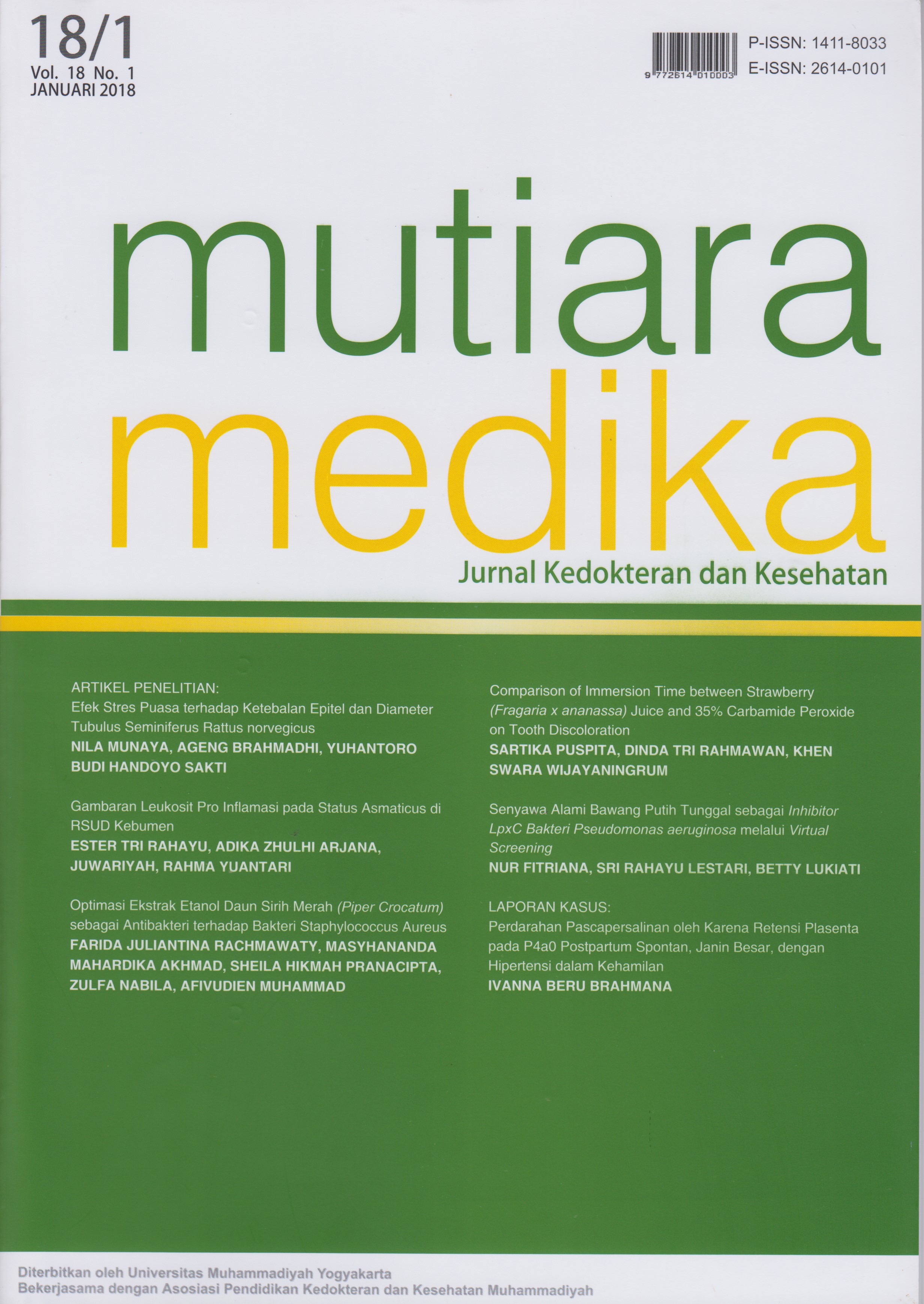Optimasi Ekstrak Etanol Daun Sirih Merah (Piper crocatum) sebagai Antibakteri terhadap Bakteri Staphylococcus aureus
DOI:
https://doi.org/10.18196/mm.180109Keywords:
Optimasi, Sirih Merah (Piper Crocatum), Antibakteri, Staphylococcus AureusAbstract
Ekstrak etanol daun sirih merah (Piper crocatum) telah diketahui memiliki aktivitas antibakteri. Sesuai namanya, bagian bawah daun sirih merah (P. crocatum) berwarna merah sedangkan bagian atas berwarna hijau dengan corak keperakan, namun ternyata daun sirih merah dapat mengalami perubahan warna pada kondisi tertentu. Warna daun dapat berubah menjadi hijau semua (tidak ada warna merah dan corak keperakan). Di sisi lain aktivitas antibakteri ekstrak akan berfungsi efektif apabila pelarut yang digunakan tepat. Penelitian ini bertujuan untuk mengetahui ekstrak daun yang lebih efektif antara yang berwarna merah dan berwarna hijau. Tujuan berikutnya untuk mengetahui pelarut yang lebih efektif antara dimetil sulfoxid (DMSO) 10%, Tween 80 1% dan aquades. Penelitian ini menggunakan metode dilusi serial untuk mengetahui Kadar Hambat Minimal (KHM) dan Kadar Bunuh Minimal (KBM) ekstrak etanol daun P. crocatum terhadap bakteri Staphylococcus aureus pada ekstrak daun berwarna berbeda dan pelarut yang berbeda. Konsentrasi yang digunakan yaitu 50%; 25%; 12,5%; 6,25%; 3,13%; 1,56% dan 0,78%. Hasil yang diperoleh KHM dan KBM daun warna merah 12,5% sedang untuk daun warna hijau 12,5% dan 50%. Sedangkan untuk pelarut ekstrak, DMSO dapat lebih banyak membunuh bakteri dibanding yang lain. Dengan demikian dapat disimpulkan bahwa ekstrak etanol daun P. crocatum warna merah lebih baik dibanding yang berwarna hijau. Untuk pengujian pelarut, ekstrak dengan pelarut DMSO 10%, lebih efektif dari pada Tween 80 1% dan aquades.
References
Safithri M, Fahma F. Potency of Piper crocatum Decoction as an Antihyperglycemia in Rat Strain Sprague dawley. Hayati J Biosci, 2008; 15 (1): 45.
Suratmo. Aktivitas Antioksidan dan Antikanker Ekstrak Daun Sirih Merah (P. crocatum). Tesis. Yogyakarta: Fakultas MIPA Universitas Gadjah Mada. 2008.
Rachmawaty FJ, Citra DA, Nirwani B, Nurmasitoh T, Bowo ET. Manfaat Sirih Merah (Piper crocatum) sebagai Agen Antibakterial terhadap Bakteri Gram Positif dan Bakteri Gram Negatif. JKKI, 2009; 1 (1): 1-10.
Rachmawaty FJ. Potensi Ekstrak Etanol Daun Sirih Merah (Piper crocatum) sebagai Antimikobakterium. Jurnal Ilmu Kefarmasian Indonesia, 2013; 11 (1): 60-65.
Sudewo B. Basmi Penyakit dengan Sirih Merah. Surabaya: Agromedia. 2005.
Rachmawaty FJ. Sirih Merah dalam Kajian Ilmiah. Yogyakarta: Aswaja Pressindo. 2017.
Manoi F. Sirih Merah sebagai Tanaman Multi Fungsi. Warta Puslitbangbun, 2007; 13 (2): 1-2.
Candrasari A, Romas MA, Hasbi M, Astuti OR. Uji Daya Antimikroba Ekstrak Etanol Daun Sirih Merah (Piper crocatum Ruiz & Pav.) terhadap Pertumbuhan Staphylococcus aureus ATCC 6538, Eschericia coli ATCC 11229 dan Candida albicans ATCC 10231 Secara in Vitro. Biomedika, 2012; 4 (1): 9-16.
Zuo GY, Menga FY, Haob XY, Zhanga YL, Wanga GC, Xua GL. Antibacterial Alkaloids from Chelidonium majus Linn (Papaveraceae) against Clinical Isolates of Methicillin-Resistant Staphylococcus aureus. J Pharm Pharmaceut Sci, 2009; 11 (4): 90-94.
Karou D, Savadogo A, Canini A, Yameogo S, Montesano C, Simpore J, et al. Antibacterial Activity of Alkaloids from Sida acuta. Afr J Biotechnol, 2005; 4 (12): 1452-1457.
Cushnie TP, Lamb AJ. Antimicrobial Activity of Flavonoids. Int J Antimicrob Agents, 2005; 26 (5): 343-356.
Shohaib T, Shafique M, Dhanya N, Divakar MC. Importance of Flavonoides in Therapeutics. H.J.D. Med, 2011; 3 (1): 1-18.
Quarenghi MV, Tereschuk ML, Baigori MD, Abdala LR. Antimicrobial Activity of Flowers from Anthemis cotula. Fitoterapia, 2000; 71 (6): 710-712.
Doss A, Mubarack M, Dhenabalan R. Antibacterial Activity of Tannin from the Leaves of Solanum trilobatum Linn. Indian J Sci Technol, 2009; 2 (2): 41-43.
Akiyama H, Fujii K, Yamasaki O, Oono T, Iwatsuki T. Antibacterial Action of Several Tannins agains Staphylococcus aureus. J Antimicrob Chemother, 2001; 48 (4): 487-491.
Parwata IMOA, Dewi PFS. Isolasi dan Uji Aktivitas Antibakteri Minyak Atsiri dari Rimpang Lengkuas (Alpinia galanga L.). Jurnal Kimia, 2008; 2 (2): 100-104.
Ajizah A. Sensitivitas Salmonella typhimurium terhadap Ekstrak Daun Psidium guajava L. Bioscientiae, 2004; 1 (1): 31-38.
Downloads
Published
Issue
Section
License
Copyright
Authors retain copyright and grant Mutiara Medika: Jurnal Kedokteran dan Kesehatan (MMJKK) the right of first publication with the work simultaneously licensed under an Attribution 4.0 International (CC BY 4.0) that allows others to remix, adapt and build upon the work with an acknowledgment of the work's authorship and of the initial publication in Mutiara Medika: Jurnal Kedokteran dan Kesehatan (MMJKK).
Authors are permitted to copy and redistribute the journal's published version of the work (e.g., post it to an institutional repository or publish it in a book), with an acknowledgment of its initial publication in Mutiara Medika: Jurnal Kedokteran dan Kesehatan (MMJKK).
License
Articles published in the Mutiara Medika: Jurnal Kedokteran dan Kesehatan (MMJKK) are licensed under an Attribution 4.0 International (CC BY 4.0) license. You are free to:
- Share — copy and redistribute the material in any medium or format.
- Adapt — remix, transform, and build upon the material for any purpose, even commercially.
This license is acceptable for Free Cultural Works. The licensor cannot revoke these freedoms as long as you follow the license terms. Under the following terms:
Attribution — You must give appropriate credit, provide a link to the license, and indicate if changes were made. You may do so in any reasonable manner, but not in any way that suggests the licensor endorses you or your use.
- No additional restrictions — You may not apply legal terms or technological measures that legally restrict others from doing anything the license permits.






